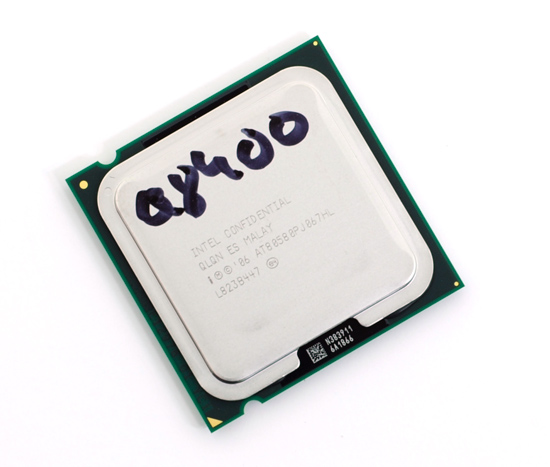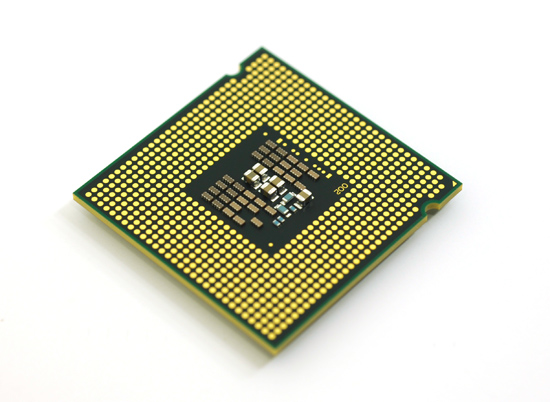The Core 2 Quad Q8400: Intel's $183 Phenom II 940 Competitor
by Anand Lal Shimpi on May 7, 2009 12:00 AM EST- Posted in
- CPUs
I’ve been writing about the “new” Intel for nearly three years now. It’s been so long that I almost forgot what the old Intel was like. It’s not that the old Intel wasn’t competitive performance-wise, it’s that the old Intel wasn’t pleasant to work with. The old Intel was the one that always thought the Pentium 4 was the fastest thing on the planet, even when it wasn’t. The old Intel wasn’t forthcoming with information and acted like it worked in a world where it had no competition. The old Intel wasn’t a very good Intel.
The new one is nothing like that. We get open sharing of information, real discussion about AMD’s strengths and weaknesses and it also helps that we also get the world’s fastest microprocessors with it.
We’ve seen that the new Intel can stand the test of time, at least over the past three years. But can the new Intel last when it’s not always winning reviews? Sure, Intel’s Core i7 remains untouched but what about at cheaper price points? Last month we found out that Intel is quite competitive at the $70 with its Pentium E5300. But between the $70 E5300 and the $280 Core i7-920 there are a few price points where AMD is recommendable.
The question then becomes how does the new Intel deal when it isn’t the fastest on the market?
Surprisingly well it turns out.
This is the Core 2 Quad Q8400:

It’s a quad-core chip running at 2.66GHz with a 2MB L2 per pair of cores (4MB total). It’s like two Pentium Dual Core processors on a single package.
These chips actually have a 6MB L2 but with 2MB disabled either because they have irrecoverable defects in the cache or simply to hit the right price point. In other words, the Q8400 is literally a Q9400 but with 2MB of its L2 disabled.

The Q8400 is Intel’s most recent response to the Phenom II X4 940. Initially AMD priced the 940 similarly to the Q9400. Then, Intel cut prices so that the 940 had to compete with the much faster Q9550. AMD responded, with a price cut that put the 940 on par with the Q9400 again.
Once AMD began shipping Socket-AM3 Phenom IIs, it dropped the prices on its Socket-AM2+ parts once more. This wasn’t so much a price cut but rather a gradual phasing out of the AM2+ CPUs, eventually I expect an AM3-only market since those chips can also work in AM2+ boards.
Rather than take the bait and drop the Q9400 prices once more, Intel instead responded with the introduction of a similarly priced Q8400 at $183.
AMD’s Phenom II X4 940 was generally the same speed if not faster than Intel’s Core 2 Quad Q9400. With less cache, the Q8400 shouldn’t perform any better than the Q9400, so the question is - does it perform any worse?
Then there’s power consumption to worry about and overclocking, but we’ll get to those in due time. Let’s just say that the situation is far more complex than it seemed at first sight.










60 Comments
View All Comments
TA152H - Friday, May 8, 2009 - link
Because of Windows XP virtualization? Are you crazy?OK, here's a reality check for those who think Windows XP virtualization is the greatest thing since the Atom Bomb.
It's not, it's a kludge, and if you want Windows XP, get Windows XP. It's going to be slower, because virtualization does have overhead, and running it in some virtual mode isn't the same as running something in XP.
How many applications really only run in XP anyway???? Show me a software vendor in this day that only supports apps in XP, and I'll show you one that's going out of business, really soon. They're incompetent.
If you're a software vendor, whether you like it or not, Vista is taking over, simply because Microsoft has it pre-installed on the vast majority of machines.
Backwards compatibility of this type can be helpful in some situations, but the importance is getting way overblown. It's not a show-stopper for the vast majority of people buying a PC, price is, and the Pentium branded CPUs offered a lot of value for the performance they give, and are excellent products.
Judging them from something of limited use, on an operating system that has not even been released, about a feature Microsoft announced a few weeks ago, is completely unfair to Intel. Going back before the Microsoft announcement, did anyone think people would be using that feature much on a budget processor? It was a good way for Intel to avoid Pentiums being used in an unintended market. Now, they might change it, since the use is more universal, but it is hardly damning for them to not have included it.
I do not know when Microsoft decided to tell Intel about this, but, it could very well have been after Intel finalized their specifications on the chips. If Intel's next Pentiums do not have this feature, I might be a little less understanding of it, but really, it is does not remove them as a choice, because it is really not as useful as people are saying. I would probably never use the feature, virtually (no pun intended) all apps run on Vista now, or have a version that runs on it, and Windows XP apps running on Windows 7 will not be as fast as those running on Windows XP. I don't think I'll have too much need for this type of kludge. But if you do, get a processor that does support it.
GeorgeH - Friday, May 8, 2009 - link
Crazy? One can never be sure, but the voices say no.XP Mode is something most people will never need, use, or be aware of and is most definitely not the best thing since the "Atom Bomb." (Aside: If the "Atom Bomb" is your go-to comparison for all things great, you might want to do some crazy checks of your own.)
Both AMD and Intel offer about the same performance at the same price points in budget and midrange quad cores. However, AMD's offerings can perform tasks that Intel's simply cannot. Even if the chance of you wanting to perform those tasks is miniscule, you'd have to be a fool to select the hamstrung Intel offerings.
You can play the Intel apologist all you want, but the fact is that Intel deliberately disabled VT support in an attempt to force their customers into purchasing more expensive processors if they wanted a fully functional PC. Microsoft is blameless here; Intel simply got too greedy and as a result is now being caught with their pants down.
taisingera - Thursday, May 7, 2009 - link
They could do something like Q8310 or E7410 to show that there is a bit more value in the cpu.leomax999 - Thursday, May 7, 2009 - link
Intel has announced vt support for Q8300, E7400, E7500, E5300, E5400.So i dont see any reason why q8400 shouldnt get it.
http://www.tcmagazine.com/comments.php?shownews=25...">http://www.tcmagazine.com/comments.php?shownews=25...
Anand Lal Shimpi - Friday, May 8, 2009 - link
You are very correct - Intel just informed me that the Q8400 has VT-x from the start. The other CPUs you mentioned will get VT in the latest versions but I don't believe it's retroactive. I believe it's a new silicon revision for those chips that enables it, but all Q8400s have it.Take care,
Anand
piroroadkill - Thursday, May 7, 2009 - link
iirc amd-v is better than intel vtduploxxx - Thursday, May 7, 2009 - link
oh great 2 versions of cpu just because of painfull wrong marketing decissions in the past.way to go intel ....and what about all the other q8xxx series? or a full list of mobile cpu's
Samus - Thursday, May 7, 2009 - link
its just disabled in hardware, which means it can be re-enabled, just like cores can be re-enabled on phenom x3. just let someone figure it out. they will. they always do :)Roland00 - Friday, May 8, 2009 - link
you can re-enable the Phenom II tri cores for they were disabled via software.If the chip is disable via hardware (using a laser to disable parts of the chip) then there is nothing you can do to re-enable the chip. Then first generation Phenoms can't be re-enabled for it was disabled via hardware.
JumpingJack - Saturday, June 6, 2009 - link
Depends on how it is disabled. Fusing in a chip can be actual diabling of circuits or actual 1's and 0's that make the logic read by the BIOS at startup (such as CPUID), the CPUID then dictates from BIOS code feature sets etc. etc. that are enabled.This is how quads arise from tri-cores and dual cores from AMD -- the core is not physically fused off/disconnected, rather the BIOS reads a certain CPUID and identifies it as 'a tri-core'. In such a case, features can be turned 'on' or 'off' simply by updating the BIOS.